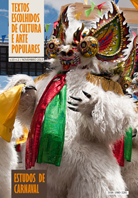UNCOMFORTABLE NEIGHBORHOOD: VIZINHA FALADEIRA AND THE FORMATION OF SAMBA SCHOOLS IN RIO DE JANEIRO IN THE 1930S
DOI:
https://doi.org/10.12957/tecap.2013.10217Keywords:
SAMBA SCHOOLS, VIZINHA FALADEIRA, PORTELA, CULTURAL STUDIES, TRADITION.Abstract
The trajectory of the samba school Vizinha Faladeira (Talkative Neighbor) (1933-1940) is an example for the understanding of the first formative years of these carnival groups in Rio de Janeiro. The grandeur, luxury and originality displayed by this group in its parades established a form of template to be criticized by all the samba groups that negotiated their recognition insociety based on values linked to tradition, purity and blackness. We propose that the symbolic battle over the significance of these carnival groups was instrumental in building therelationship between the samba schools and traditionalism, and the permanence of these groups in the national imagination as the main representatives of the popular carnival from the 1940sonwards.Published
2013-11-01
How to Cite
Turano, G. da C., & Ferreira, F. (2013). UNCOMFORTABLE NEIGHBORHOOD: VIZINHA FALADEIRA AND THE FORMATION OF SAMBA SCHOOLS IN RIO DE JANEIRO IN THE 1930S. Textos Escolhidos De Cultura E Arte Populares, 10(2). https://doi.org/10.12957/tecap.2013.10217
Issue
Section
Articles
License
Autores que publicam nesta revista concordam com os seguintes termos:- Autores mantém os direitos autorais e concedem à revista o direito de primeira publicação, com o trabalho simultaneamente licenciado sob a Licença Creative Commons Attribution que permite o compartilhamento do trabalho com reconhecimento da autoria e publicação inicial nesta revista.
- Autores têm autorização para assumir contratos adicionais separadamente, para distribuição não-exclusiva da versão do trabalho publicada nesta revista (ex.: publicar em repositório institucional ou como capítulo de livro), com reconhecimento de autoria e publicação inicial nesta revista.
- Autores têm permissão e são estimulados a publicar e distribuir seu trabalho online (ex.: em repositórios institucionais ou na sua página pessoal) a qualquer ponto antes ou durante o processo editorial, já que isso pode gerar alterações produtivas, bem como aumentar o impacto e a citação do trabalho publicado (Veja O Efeito do Acesso Livre).

